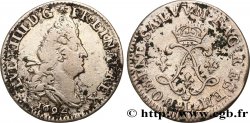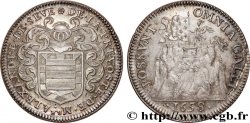Live auction - fme_782336 - LOUIS XIV "THE SUN KING" Médaille, Pyramide élevée à Rome
You must signin and be an approved bidder to bid, LOGIN TO BID. Accounts are subject to approval and the approval process takes place within 48 hours. Do not wait until the day a sale closes to register. Clicking on "BID" constitutes acceptance of the terms of use of cgb.fr private live auctions.
Bids must be placed in whole Euro amounts only. The sale will start closing at the time stated on the item description; any bids received at the site after the closing time will not be executed. Transmission times may vary and bids could be rejected if you wait until the last second. For further information check the Live auction FAQ
All winning bids are subject to a 18% buyer’s fee.
All winning bids are subject to a 18% buyer’s fee.
| Estimate : | 150 € |
| Price : | 75 € |
| Maximum bid : | 75 € |
| End of the sale : | 24 January 2023 18:16:18 |
| bidders : | 1 bidder |
Type : Médaille, Pyramide élevée à Rome
Date: 1664
Metal : copper
Diameter : 41 mm
Orientation dies : 12 h.
Engraver MAUGER Jean (1648-1712)
Weight : 31,32 g.
Edge : lisse
Puncheon : sans poinçon
Coments on the condition:
Patine marron hétérogène d’aspect irisé, présentant quelques taches d’oxydation. Petite usure sur les hauts reliefs. Présence de quelques rayures
Catalogue references :
Obverse
Obverse legend : LUDOVICUS XIIII . REX CHRISTIANISSIMUS..
Obverse description : Buste de Louis XIV à droite, signé I. MAVGER. F.
Obverse translation : (Louis XIV, roi très chrétien).
Reverse
Reverse legend : OB NEF. SCELUS A CORSIS EDIT. IN ORAT. REG. FR // À L’EXERGUE : POSITA PYRAMIDE / M DC LXIV.
Reverse description : La ville de Rome, sous la figure d’une femme assise, tenant un javelot et un bouclier sur lequel on lit : ROMA. A droite la nouvelle pyramide.
Commentary
En août 1662, les gardes de l’ambassadeur du roi de France à Rome eurent une querelle avec les gardes corses du pape. Du côté français, il y eut des blessés et même un mort. Comme la cour de Rome hésitait à présenter ses excuses, l’ambassadeur quitta la ville. Louis XIV, de son côté, ordonna le nonce apostolique de quitter la cour et occupa Avignon et le Comtat Venaissin. une guerre semblait éclater d’un moment à l’autre.
Finalement, une paix fut conclue entre le pape Alexandre VII et le roi de France. Louis XIV restituait le Comtat et le pape en échange offrait comme réparation le renvoi de la garde corse, une déclaration d’excuses du nonce et l’érection d’une pyramide à Rome, en mémoire à ces excuses.
La pyramide fut érigée au commencement de l’année 1664. Le 29 juillet de la même année, le neveu du pape, le cardinal Chigi, fut reçu en audience dans la chambre du roi et présenta les excuses de Rome (médaille 79). Le pape Clément IX, le successeur d’Alexandre VII, désirait la destruction de la pyramide, ce témoignage de l’humiliation papale. Louis XIV finit par donner son consentement et la pyramide fut détruite en 1668.
In August 1662, the guards of the King of France's ambassador in Rome had a quarrel with the Pope's Corsican guards. On the French side, there were injuries and even one death. As the court in Rome hesitated to apologize, the ambassador left the city. Louis XIV, for his part, ordered the papal nuncio to leave the court and occupied Avignon and the Comtat Venaissin. A war seemed likely to break out at any moment. Finally, peace was concluded between Pope Alexander VII and the King of France. Louis XIV returned the Comtat, and the Pope, in exchange, offered as reparations the dismissal of the Corsican guard, a declaration of apology from the nuncio, and the erection of a pyramid in Rome as a memorial to these apologies. The pyramid was erected at the beginning of 1664. On July 29 of the same year, the Pope's nephew, Cardinal Chigi, was received in audience in the king's chamber and presented Rome's apologies (medal 79). Pope Clement IX, the successor of Alexander VII, desired the destruction of the pyramid, this testimony to papal humiliation. Louis XIV finally gave his consent and the pyramid was destroyed in 1668
Finalement, une paix fut conclue entre le pape Alexandre VII et le roi de France. Louis XIV restituait le Comtat et le pape en échange offrait comme réparation le renvoi de la garde corse, une déclaration d’excuses du nonce et l’érection d’une pyramide à Rome, en mémoire à ces excuses.
La pyramide fut érigée au commencement de l’année 1664. Le 29 juillet de la même année, le neveu du pape, le cardinal Chigi, fut reçu en audience dans la chambre du roi et présenta les excuses de Rome (médaille 79). Le pape Clément IX, le successeur d’Alexandre VII, désirait la destruction de la pyramide, ce témoignage de l’humiliation papale. Louis XIV finit par donner son consentement et la pyramide fut détruite en 1668.
In August 1662, the guards of the King of France's ambassador in Rome had a quarrel with the Pope's Corsican guards. On the French side, there were injuries and even one death. As the court in Rome hesitated to apologize, the ambassador left the city. Louis XIV, for his part, ordered the papal nuncio to leave the court and occupied Avignon and the Comtat Venaissin. A war seemed likely to break out at any moment. Finally, peace was concluded between Pope Alexander VII and the King of France. Louis XIV returned the Comtat, and the Pope, in exchange, offered as reparations the dismissal of the Corsican guard, a declaration of apology from the nuncio, and the erection of a pyramid in Rome as a memorial to these apologies. The pyramid was erected at the beginning of 1664. On July 29 of the same year, the Pope's nephew, Cardinal Chigi, was received in audience in the king's chamber and presented Rome's apologies (medal 79). Pope Clement IX, the successor of Alexander VII, desired the destruction of the pyramid, this testimony to papal humiliation. Louis XIV finally gave his consent and the pyramid was destroyed in 1668








 Report a mistake
Report a mistake Print the page
Print the page Share my selection
Share my selection Ask a question
Ask a question Consign / sell
Consign / sell
 Full data
Full data










